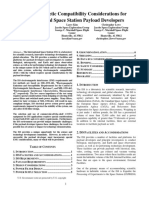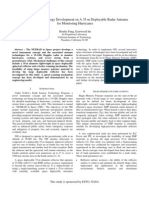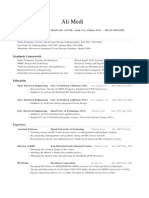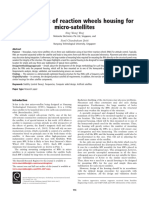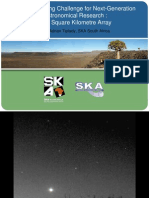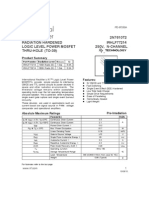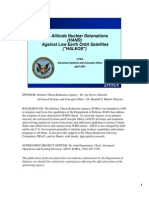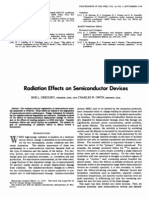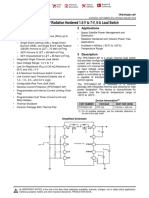Radiation Hardened Electronics For Space Environments (RHESE)
Radiation Hardened Electronics For Space Environments (RHESE)
Uploaded by
wingman358Copyright:
Available Formats
Radiation Hardened Electronics For Space Environments (RHESE)
Radiation Hardened Electronics For Space Environments (RHESE)
Uploaded by
wingman358Original Title
Copyright
Available Formats
Share this document
Did you find this document useful?
Is this content inappropriate?
Copyright:
Available Formats
Radiation Hardened Electronics For Space Environments (RHESE)
Radiation Hardened Electronics For Space Environments (RHESE)
Uploaded by
wingman358Copyright:
Available Formats
Military and Aerospace FPGA and Applications (MAFA)
Exploration Technology Development Program’s
Radiation Hardened
Electronics for Space
Environments (RHESE)
Andrew S. Keys, James H. Adams, Donald O. Frazier, Marshall C. Patrick, and
Michael D. Watson
NASA Marshall Space Flight Center, Huntsville, AL 35812
Michael A. Johnson
NASA Goddard Space Flight Center, Greenbelt, MD 20771
John D. Cressler
Georgia Institute of Technology, Atlanta, GA 30332-0250
Elizabeth A. Kolawa
Jet Propulsion Laboratory, Pasadena, CA 91109
RHESE
MAFA–-27
Integrated
NovemberBaseline
2007 Review – 12 September 2007
Vision for Space Exploration
• The Vision for Space
Exploration (VSE) directs
NASA to pursue a long-
term human and robotic
program to explore the
solar system.
• The VSE is based on the
following goals:
– Return the shuttle to flight
(following the Columbia
accident) and complete the
International Space Station
by 2010.
– Develop a Crew Exploration
Vehicle, test by 2008, first
manned mission no later
than 2014.
– Return to the Moon as early
as 2015 and no later than
2020.
• Gain experience and
knowledge for human missions
to Mars.
• Increase the use of robotic
exploration to maximize our
understanding of the solar
system.
SPACE 2007 – 20 September 2007 2
Constellation Program
• The Constellation Program consists of multiple projects,
jointly being developed to fulfill the goals of the VSE.
Ares V Launch
Vehicle
Ares I Launch
Vehicle
Lunar Lander
Orion Crew
Exploration Vehicle
Lunar Outpost
SPACE 2007 – 20 September 2007 3
Surviving the Radiation Environment
• Space Radiation
affects all spacecraft.
– Spacecraft electronics
have a long history of
power resets, safing,
and system failures
due to:
• Long duration
exposures,
• Unpredictable solar
proton activity,
• Ambient galactic
cosmic ray
environment.
SPACE 2007 – 20 September 2007 4
The Radiation Environment
• Multiple approaches may be employed (independently or in
combination) to protect electronic systems in the radiation
environment:
– Shielding,
– Mission Design (radiation avoidance),
– Radiation Hardening by Architecture,
• Commercial parts in redundant and duplicative configurations (Triple Module
Redundancy),
• Increases overhead in voting logic, power consumption, flight mass
• Multiple levels of redundancy implemented for rad-damage risk mitigation:
– Component level
– Board level
– Subsystem level
– Spacecraft level
– Radiation Hardening by Design,
• TMR strategies within the chip layout,
• designing dopant wells and isolation trenches into the chip layout,
• implementing error detecting and correction circuits, and
• device spacing and decoupling.
– Radiation Hardening by Process,
• Employ specific materials, processing techniques,
• Usually performed on dedicated rad-hard foundry fabrication lines.
SPACE 2007 – 20 September 2007 5
Radiation Hardened Assurance
• NASA spacecraft developers have defined a Radiation
Hardness Assurance (RHA) methodology process*.
• In general, the process may be described by the following
steps:
– 1) define the radiation hazard,
– 2) evaluate the hazard,
– 3) define the requirements to be met by the spacecraft’s electronics,
– 4) evaluate the electronics to be used,
– 5) engineer processes to mitigate hazard damage, and
– 6) iterate on the methodology, if and when necessary.
• To promote the successful implementation of RHA for
Constellation (and other NASA) missions, the RHESE project
aims to deliver products that assist in mitigating the hazard
damage.
*LaBel, K. A., Johnson, A. H., Barth, J. L., Reed, R. A., and Barnes, C. E., “Emerging Radiation
Hardness Assurance(RHA) Issues: A NASA Approach for Space Flight Programs,” IEEE Transactions
on Nuclear Science, Vol. 45, No. 6, Dec. 1998, pp. 2727-2736.
SPACE 2007 – 20 September 2007 6
RHESE Overview and Objectives
The Radiation Hardened Electronics for Space
Environments (RHESE) project expands the current
state-of-the-art in radiation-hardened electronics to develop
high performance devices robust enough to withstand the
demanding radiation and thermal conditions encountered
within the space and lunar environments.
The specific goals of the RHESE project are to foster technology
development efforts in radiation-hardened electronics possessing
these associated capabilities:
– improved total ionization dose (TID) tolerance,
– reduced single event upset rates,
– increased threshold for single event latch-up,
– increased sustained processor performance,
– increased processor efficiency,
– increased speed of dynamic reconfigurability,
– reduced operating temperature range’s lower bound,
– increased the available levels of redundancy and reconfigurability, and
– increased the reliability and accuracy of radiation effects modeling.
SPACE 2007 – 20 September 2007 7
Customer Requirements and Needs
• RHESE is a “requirements-pull” technology development effort.
• RHESE is a “cross-cutting” technology, serving a broad base of multiple
project customers within Constellation.
– Every project requiring…
• operation in an extreme space environment,
• avionics, processors, automation, communications, etc.
…should include RHESE in its implementation trade space.
• RHESE’s products are developed in response to the needs and
requirements of multiple Constellation program elements, including:
– Ares V Crew Launch Vehicle,
– Orion Crew Exploration Vehicle’s lunar capability,
– Lunar Lander,
– Lunar Outpost,
– Surface Systems,
– Extra Vehicular Activity (EVA) elements,
– Future applications to Mars exploration architecture elements.
• Constellation Program requirements for avionics and electronics continue
to evolve and become more defined.
• RHESE will develop products per derived requirements based on the
Constellation Architecture’s Level I and Level II requirements defined to
date.
SPACE 2007 – 20 September 2007 8
RHESE Tasks
• Specifically, the RHESE tasks are:
– Model of Radiation Effects on Electronics (MREE),
– Single Event Effects (SEE) Immune Reconfigurable Field
Programmable Gate Array (FPGA) (SIRF),
– Radiation Hardened High Performance Processors (HPP),
– Reconfigurable Computing (RC),
– Silicon-Germanium (SiGe) Integrated Electronics for Extreme
Environments.
SPACE 2007 – 20 September 2007 9
MREE Technology Objectives
• The Main Objective
– A computational tool to estimate radiation
effects in space in support of spacecraft design
• Total dose
• Single Event Effects
• Secondary Objectives
– To provide a detailed description of the
radiation environment in support of radiation
health and instrument design
• In deep space
• Inside the magnetosphere
• Behind shielding
SPACE 2007 – 20 September 2007 10
Update the Method for SEE Calculation
CREME96 MREE
Integral over
path length
Distribution + Multi-volume Calorimetry +
critical charge Charge-collection models +
Critical charge
SPACE 2007 – 20 September 2007 11
SIRF Drivers
• Reconfigurable gate arrays form the basis of many adaptable,
scaleable, computing engines
– Add flexibility, capability and robustness to surface and flight systems
SPACE 2007 – 20 September 2007 12
SIRF Architecture
Based on Commercial Devices
• 5th generation Virtex™ device
• Columnar Architecture enables
resource “dial-in” of
– Logic
– Block RAM
– I/O
– DSP Slices
– PowerPC Cores
Fabrication process and device architecture
yield a high speed, flexible component
SPACE 2007 – 20 September 2007 13
SIRF Objective
Radiation-hardened Device
• Existing reconfigurable FPGAs are very susceptible to radiation-
induced single event effects
– Significant FPGA resources are currently required to mitigate radiation-
induced single event effects
… …
SIRF technology
Current technology
…
…
Rad-Susceptible SIRF Fabric
FPGA Fabric - Logic function
User invoked TRM required Mitigation implemented at device level
(requires FPGA resources)
Objectives: Eliminate need for user-invoked TMR. Bring a state-of-the-art radiation
hardened reconfigurable FPGA to the space electronics market by ~2010.
SPACE 2007 – 20 September 2007 14
HPP Drivers
• Problem: Exploration Systems Missions
Directorate objectives and strategies
can be constrained by computing
capabilities and power efficiencies
– Autonomous landing and hazard
avoidance systems
– Autonomous vehicle operations
– Autonomous rendezvous and docking
– Vision systems
SPACE 2007 – 20 September 2007 15
HPP Technical Approach
Multi-generation Performance Lag
• Radiation-hardened processors lag commercial devices by several technology generations
(approx. 10 years)
– RHESE High performance Processor project full-success metric for general purpose processors
conservatively keeps pace with historical trend (~Moore’s Law)
Core 2
1E4 Pentium IV HPP General
Purpose Processor
Performance Metric
2000
Pentium III
1000
Pentium Pro PPC440
Processor Throughput
LEON3
Pentium PPC603e RAD750 RT ULP ColdFire1
100
80486DX
(MIPS)
Commercial Processor R6000
Radiation-hardened processor Mongoose V
10 80386DX
w
La
’s
re
oo
w
La
M
1.0 ’s
re
80286
oo
M
0.1
8080
1970 1980 1990 2000 2010 2020
~10 yrs. Lunar Lunar
Year EVA Outposts
PDR Dates
CEV LSAM
Block II Lander
M.A.Johnson/GSFC SPACE 2007 – 20 September 2007 16
Reconfigurable Computing
Subproject
• Subproject Objectives
• Provide reconfigurable computing capabilities as a preferred alternative to
conventional forms
– Processor Modularity
– Interface Modularity
• Reduction of Flight Spares
• Accommodation for Circuit Life Limitations
• Resources where needed, as needed
• Supplement other efforts to mitigate environmental impacts by providing the
capability to detect and work around malfunctioning circuitry
– Fault Tolerance
– Fault Detection, Isolation, and Mitigation
•
• Generally: capitalize on the unique capabilities of RC to adapt in target
systems for changing requirements, performance and environmental
parameters
SPACE 2007 – 20 September 2007 17
RC Technical Justification
Reconfigurable Computing Subproject
• Flight-Qualified, Multi-String Redundant Hardware is Expensive
– Development, Integration, IV&V, and Flight Qualification
– Space and Weight
– Power Consumption and Cooling
• Custom Design of Computing Resources for Every New Flight System
or Subsystem is Unnecessary and Wasteful
• Requirements for Flexibility are Increasing and Make Sense
– Reconfigurable (Flexible) and Modular Capabilities
– For Dissimilar Spares, and Incremental Changeover to New Technology:
Capacity to use one system to back up any number of others
– General Reusability
• Current Options for Harsh/Flight Environment Systems are Limited
– Custom Hardware, Firmware, and Software
– Dedicated and Inflexible
– Often Proprietary: Collaboration Inhibited
• Modular Spares == Fewer Flight Spares
SPACE 2007 – 20 September 2007 18
SiGe Technology
The Moon: A Classic Extreme Environment!
Current Rovers / Robotics
Extreme Temperature Ranges:
+120C to -180C (300C T swings!)
28 day cycles
-230C in shadowed polar craters
Radiation:
100 krad over 10 years
single event effects (SEE)
solar events
Many Different Circuit Needs: Requires “Warm Box”
digital building blocks
analog building blocks
data conversion (ADC/DAC)
RF communications
actuation and control
sensors / sensor interfaces
Highly Mixed-Signal Flavor
SPACE 2007 – 20 September 2007 19
SiGe-Based Remote Electronics Unit (REU)
The X-33 Remote Health Our Project End Game:
Monitoring Node, The SiGe ETDP Remote
circa 1998 Electronics Unit, circa 2009
(BAE)
REU in
connector
housing!
Analog front Digital
Specifications end die control die
• 5” wide by 3” high by 6.75”
long = 101 cubic inches
Conceptual integrated REU
• 11 kg weight system-on-chip SiGe BiCMOS die
• 17.2 Watts power dissipation Our Goals
• -55oC to +125oC • 1.5” high by 1.5” wide by 0.5”
long = 1.1 cubic inches
• < 1 kg
• < 1-2 Watts
• -180oC to +125oC, rad tolerant!
Supports MANY Sensor Types:
Temperature, Strain, Pressure, Acceleration, Vibration, Heat Flux, Position, etc.
Use This REU as a Remote Vehicle Health Monitoring Node
SPACE 2007 – 20 September 2007 20
RHESE Summary
• All RHESE tasks are “requirements-
pulled” by specific Constellation
Architecture Requirements Document
(CARD) requirements, Lunar
Architecture Team (LAT) technology
needs, and surface systems’ defined
environments.
• An application-dependent trade space
is defined by:
– Radiation Hardening by Architecture
using COTS processors, and
– Radiation Hardening By Design using
Rad-Hard processors.
– Considerations include performance
requirements, power efficiency, design
complexity, radiation
• Radiation and low temperature
environments currently drive spacecraft
system architectures.
– Centralized systems to keep
electronics warm are costly, weighty
and use excessive cable lengths.
– Mitigation can be achieved by active
SiGe electronics.
SPACE 2007 – 20 September 2007 21
RHESE Summary
• Radiation Environmental Modeling is
crucial to proper predictive modeling
and electronic response to the
radiation environment.
– When compared to on-orbit data,
CREME96 has been shown to be
inaccurate in predicting the radiation
environment.
– The NEDD bases much of its radiation
environment data on CREME96 output.
• Close coordination and partnership with
DoD radiation-hardened efforts will result
in leveraged - not duplicated or
independently developed - technology
capabilities of:
– Radiation-hardened, reconfigurable FPGA-
based electronics,
– High Performance Processors (NOT
duplication or independent development).
SPACE 2007 – 20 September 2007 22
You might also like
- Tim Girard Resume 8 2013Document3 pagesTim Girard Resume 8 2013sundar_subash25No ratings yet
- MEM Gyros For Space ApplicationsDocument12 pagesMEM Gyros For Space ApplicationsHongraekim100% (1)
- Modelcenter Lockheed Martin Space Case StudyDocument4 pagesModelcenter Lockheed Martin Space Case StudyzhouyeNo ratings yet
- Radio Frequency Payloads Tutorial EDHPC 2023Document116 pagesRadio Frequency Payloads Tutorial EDHPC 2023Sriram TallapragadaNo ratings yet
- SmexliteDocument12 pagesSmexliteLenina Viktoriya TeknyetovaNo ratings yet
- In-Situ AbstDocument5 pagesIn-Situ AbstFahim MunawarNo ratings yet
- On-Board Processing BenchmarksDocument9 pagesOn-Board Processing BenchmarksBoul chandra GaraiNo ratings yet
- Satellite Pose Estimation Challenge: Dataset, Competition Design and ResultsDocument15 pagesSatellite Pose Estimation Challenge: Dataset, Competition Design and Resultscds.asal.dzNo ratings yet
- Inflatable Antenna Technology With Preliminary ShuDocument7 pagesInflatable Antenna Technology With Preliminary ShudivyaNo ratings yet
- An Architecture For Self-Fabricating Space SystemsDocument17 pagesAn Architecture For Self-Fabricating Space SystemsWalfarid LimbongNo ratings yet
- Farina 2013Document8 pagesFarina 2013desgdesg007No ratings yet
- SDNX Cansat NepalDocument3 pagesSDNX Cansat NepalSagar aryalNo ratings yet
- Lars Osborne Resume Feb2019Document1 pageLars Osborne Resume Feb2019api-251232177No ratings yet
- Cavaciuti-Davis-Heying ISAM 20220715Document26 pagesCavaciuti-Davis-Heying ISAM 20220715sghscribd2012No ratings yet
- Spacecraft Mechanical Sub-System Design & Manufacturing Introductory CourseDocument79 pagesSpacecraft Mechanical Sub-System Design & Manufacturing Introductory CoursekirancallsNo ratings yet
- IAC 19, A7,1,5, x49711Document15 pagesIAC 19, A7,1,5, x49711pacoNo ratings yet
- MentDocument38 pagesMentJob JuliusNo ratings yet
- AeroDocument12 pagesAeromsamis8293No ratings yet
- Design Thinking AnuragDocument8 pagesDesign Thinking AnuragAtharv TiwariNo ratings yet
- Emc Iss 20200002330Document9 pagesEmc Iss 20200002330mdurna2000No ratings yet
- Sabo Gal 2019Document12 pagesSabo Gal 2019kavyaNo ratings yet
- Airphoton Satellite PayloadsDocument18 pagesAirphoton Satellite PayloadsVasudev PurNo ratings yet
- Vemana ReddySat Progress - ReportDocument33 pagesVemana ReddySat Progress - Reportlucifercat123No ratings yet
- IAC-17.C4.4.3 Current Status of Nasa'S Next-C Ion Propulsion System Development Project Rohit ShastryDocument5 pagesIAC-17.C4.4.3 Current Status of Nasa'S Next-C Ion Propulsion System Development Project Rohit Shastrykilikol174No ratings yet
- AI For Space ApplicationsDocument15 pagesAI For Space ApplicationsKeerthan GowdaNo ratings yet
- Design SpecificationsDocument2 pagesDesign SpecificationsTaranjit SinghNo ratings yet
- International Requirements For Payload Multi-Platform Reuse MethodologyDocument7 pagesInternational Requirements For Payload Multi-Platform Reuse MethodologyAmin R.No ratings yet
- Ssea 2022 58Document6 pagesSsea 2022 58Christian nuñezNo ratings yet
- Group 2Document14 pagesGroup 2venic56674No ratings yet
- Systema Overview: Integrated Solutions For Space EngineeringDocument35 pagesSystema Overview: Integrated Solutions For Space EngineeringzuiliNo ratings yet
- Mars Relay PowerStar RFI ConceptDocument25 pagesMars Relay PowerStar RFI ConceptShawn Paul Boike100% (1)
- AI Planning Applications and Execution 16x9 v4Document42 pagesAI Planning Applications and Execution 16x9 v4Yogendra ReddyNo ratings yet
- RISATDocument10 pagesRISATSHAGUN YADAVNo ratings yet
- Information Technology Preparations For The Pluto Encounter From Mission Operations To Science RetrievalDocument6 pagesInformation Technology Preparations For The Pluto Encounter From Mission Operations To Science RetrievalBrian JonesNo ratings yet
- Ernst 等 - 2023 - Architecting Complex, Long-Lived Scientific SoftwaDocument27 pagesErnst 等 - 2023 - Architecting Complex, Long-Lived Scientific SoftwasnamesunNo ratings yet
- NASA: b6p2Document6 pagesNASA: b6p2NASAdocumentsNo ratings yet
- IAC 20, A3,2C, 30, x59667Document10 pagesIAC 20, A3,2C, 30, x59667Cristina RecuperoNo ratings yet
- LEO Based Satellite Navigation and Anti-Theft Tracking System For AutomobilesDocument9 pagesLEO Based Satellite Navigation and Anti-Theft Tracking System For AutomobilesIJRASETPublicationsNo ratings yet
- Design Lab BrochureDocument6 pagesDesign Lab BrochureRahul NavghareNo ratings yet
- COTS in Space From Novelty To Necessity White Paper PDFDocument10 pagesCOTS in Space From Novelty To Necessity White Paper PDFFath GruntNo ratings yet
- Nicholas Restivo Resume2019Document2 pagesNicholas Restivo Resume2019api-474887186No ratings yet
- Clasificarea SatelitilorDocument45 pagesClasificarea SatelitilorVictoria LevinteNo ratings yet
- Mission Operations: Glen E. Baer, Raymond J. Harvey, Mark E. Holdridge, Richard K. Huebschman, and Elliot H. RodbergDocument11 pagesMission Operations: Glen E. Baer, Raymond J. Harvey, Mark E. Holdridge, Richard K. Huebschman, and Elliot H. RodbergSai KumarNo ratings yet
- Machine-Learning Space Applications On SmallSat Platforms With TeDocument8 pagesMachine-Learning Space Applications On SmallSat Platforms With Tej700159No ratings yet
- Ali Medi Resume - 2Document3 pagesAli Medi Resume - 2miladezamaniNo ratings yet
- Standardization Concepts For CubeSat ApplicationsDocument5 pagesStandardization Concepts For CubeSat Applicationsmed chahineNo ratings yet
- c2 PDFDocument48 pagesc2 PDFSantiago UrgilesNo ratings yet
- NASA Additive Manufacturing - 2017Document25 pagesNASA Additive Manufacturing - 2017Jorge OliveiraNo ratings yet
- Lecture 0 Prologue OnlineDocument35 pagesLecture 0 Prologue OnlineRachid RahmouneNo ratings yet
- Demonstration of Small Satellite TechnologiesDocument10 pagesDemonstration of Small Satellite Technologiesvitorlinhares762No ratings yet
- CCD Imager Development For AstronomyDocument21 pagesCCD Imager Development For Astronomysd6433No ratings yet
- Thermal Design of The Mars Science Laboratory Powered Descent VehicleDocument18 pagesThermal Design of The Mars Science Laboratory Powered Descent Vehicle枪手瞎炳No ratings yet
- Solevrcs. Smart OlevDocument11 pagesSolevrcs. Smart Olevrrg_abraxNo ratings yet
- Development of Reaction Wheels Housing For Micro-SatellitesDocument8 pagesDevelopment of Reaction Wheels Housing For Micro-SatellitesAGonzalezNo ratings yet
- A Shared Satellite Ground Station Using User Oriented Virtualization TechnologyDocument12 pagesA Shared Satellite Ground Station Using User Oriented Virtualization Technologyaya__ayakNo ratings yet
- An Engineering Challenge For Next-Generation Astronomical Research: The Square Kilometre ArrayDocument57 pagesAn Engineering Challenge For Next-Generation Astronomical Research: The Square Kilometre ArrayLee WoosangNo ratings yet
- Modular 1Document17 pagesModular 1x5midoxx01No ratings yet
- CartoMobile iPhone/iPad App: Optimize Ground Survey Data Collection for Airborne LIDAR Accuracy AssessmentFrom EverandCartoMobile iPhone/iPad App: Optimize Ground Survey Data Collection for Airborne LIDAR Accuracy AssessmentNo ratings yet
- Embedded Deep Learning: Algorithms, Architectures and Circuits for Always-on Neural Network ProcessingFrom EverandEmbedded Deep Learning: Algorithms, Architectures and Circuits for Always-on Neural Network ProcessingNo ratings yet
- 54 Act 157Document26 pages54 Act 157Deepa DevarajNo ratings yet
- Intersil Space ProductsDocument15 pagesIntersil Space ProductsYze Shiuan YNo ratings yet
- Mil STD 883 5Document157 pagesMil STD 883 5Eduardo José TagleNo ratings yet
- Implementing Texas Instruments Power Supplies For A Teledyne E2v DDR4 Memory in Space ApplicationsDocument5 pagesImplementing Texas Instruments Power Supplies For A Teledyne E2v DDR4 Memory in Space ApplicationsMentholNo ratings yet
- Irhlf77214 250V Radhard N MosfetDocument9 pagesIrhlf77214 250V Radhard N MosfetarsebiscuitsNo ratings yet
- HS-1840ARH: Rad-Hard 16 Channel CMOS Analog Multiplexer With High-Z Analog Input Protection FeaturesDocument7 pagesHS-1840ARH: Rad-Hard 16 Channel CMOS Analog Multiplexer With High-Z Analog Input Protection FeaturesDeepa DevarajNo ratings yet
- DC To DC Power Converters - JPDocument15 pagesDC To DC Power Converters - JPAauNo ratings yet
- Total-Dose Radiation Hardness AssuranceDocument13 pagesTotal-Dose Radiation Hardness Assurancezare6767No ratings yet
- Radiation Handbook For ElectronicsDocument118 pagesRadiation Handbook For ElectronicsSaqib Ali Khan100% (1)
- RADWG Voltage Regulator FinalDocument27 pagesRADWG Voltage Regulator FinalZhitaiLiuNo ratings yet
- TPS50601A-SP Radiation Hardened 3-V To 7-V Input, 6-A Synchronous Buck ConverterDocument35 pagesTPS50601A-SP Radiation Hardened 3-V To 7-V Input, 6-A Synchronous Buck ConverterKaren Juliana Espinosa ValeroNo ratings yet
- Hoja de DatosDocument37 pagesHoja de Datoscastillo_leoNo ratings yet
- Mil STD 883LDocument28 pagesMil STD 883Lvijay yadavNo ratings yet
- High Altitude Nuclear Detonations (HAND) Against Low Earth Orbit Satellites (HALEOS)Document32 pagesHigh Altitude Nuclear Detonations (HAND) Against Low Earth Orbit Satellites (HALEOS)Jim Lee ClimateViewerNo ratings yet
- 1994 NSREC SHORT COURSE - Radiation Effects in Commercial ElectronicsDocument257 pages1994 NSREC SHORT COURSE - Radiation Effects in Commercial ElectronicsPollyanne AlcantaraNo ratings yet
- Dexhand A Space Qualified Multi FingeredDocument7 pagesDexhand A Space Qualified Multi FingeredKhan AyanNo ratings yet
- SoA2018 Final Doc-6Document207 pagesSoA2018 Final Doc-6DiegoChaucaGallegosNo ratings yet
- Ovonic Unified MemoryDocument28 pagesOvonic Unified Memoryapi-19937584No ratings yet
- Design 3 S4P8NDocument12 pagesDesign 3 S4P8NL S Krishna MaanasNo ratings yet
- Towards The Use of Arti Ficial Intelligence On The Edge in Space Systems: Challenges and OpportunitiesDocument13 pagesTowards The Use of Arti Ficial Intelligence On The Edge in Space Systems: Challenges and OpportunitieskhalidNo ratings yet
- RAdiation Effects On Semiconductor DevicesDocument11 pagesRAdiation Effects On Semiconductor DevicesUdai SinghNo ratings yet
- IRHN7450 IRHN8450: Mega Rad HardDocument12 pagesIRHN7450 IRHN8450: Mega Rad HardBadshah SalamatNo ratings yet
- Radiation Effects On Mosfets: Deepkumar R. ShahDocument5 pagesRadiation Effects On Mosfets: Deepkumar R. Shahcarlos ricardo herrera castilloNo ratings yet
- IRHMS9A7264 InternationalRectifierDocument14 pagesIRHMS9A7264 InternationalRectifierGuh CamposNo ratings yet
- 2003fy ReportDocument683 pages2003fy Reportspmtawi lsmaipawiNo ratings yet
- Radiation-Tolerant Fpgas: Aerospace and DefenseDocument24 pagesRadiation-Tolerant Fpgas: Aerospace and DefenseJavier CoelloNo ratings yet
- Mil STD 883 1Document217 pagesMil STD 883 1Eduardo José TagleNo ratings yet
- tps7h2201 SP PDFDocument32 pagestps7h2201 SP PDFGabriel SmolnyckiNo ratings yet
- Radiation Effects and COTS Parts in SmallSatsDocument12 pagesRadiation Effects and COTS Parts in SmallSatstomek_zawistowskiNo ratings yet
- Radiation Effects On Space ElectronicsDocument21 pagesRadiation Effects On Space Electronicsdhoo_baby100% (1)




















